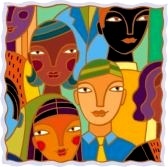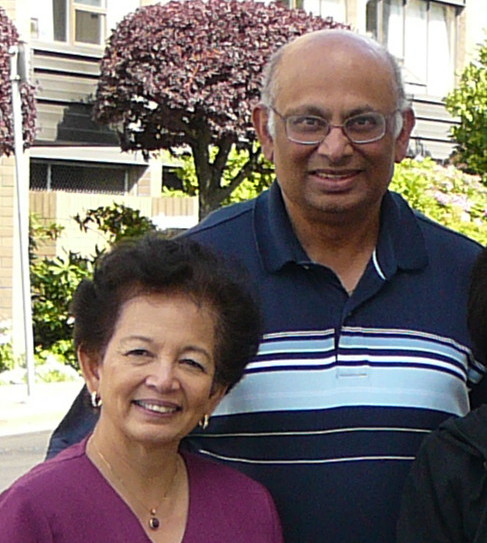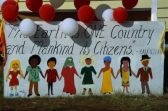|
Benild & Laila
You say salaam, I say hello By Ben J. Pires Am I being idealistic or am I being engaged in abstract, unrealistic nonsense when I seek to have a better understanding and appreciation of my neighbors’ and all peoples’ cultures, including the impact of religions on them? Or is it an opportunity for me to: q overcome my fear of dealing with peoples’ differences; q enrich my life through knowledge and experience; and, q build bridges between peoples? My attitude towards an understanding of peoples’ cultures depends on my personal culture and how I view the world around me and my brief life on earth. If I am interested in such a personal enrichment, what are the steps that I can take to reap its opportunities and benefits?
Culture: a way of life My first step to understanding cultures is to accept culture — in its broadest sense — as a way of life.
I have a culture just like you do. I was not born with a culture, nor did I inherit it. I learned my personal culture from the day I was born from my environment and everything I experienced — particularly through people around me.
What I see, hear, smell, and feel taught me — and still teaches me — how to view all things. And what I learn and experience depend on who and what is around me every moment of my life. My personal culture, like yours, has two elements: q my values, which you and I cannot largely see, but which makes up as much as 90 per cent of my culture; and, q my behavior, which is visible to all and makes up the remaining 10 per cent of my culture.. Who and what is around me directly affect my values — my beliefs (including those based on religion), attitudes, and practices, which are valuable and important to me. My behavior includes my language, gestures, actions, customs and styles. I reveal my values through my behavior.
Distinctive cultures My second step to cross-cultural understanding is to accept the fact that you and I each have a distinctive (and different) culture . . . a unique combination of our own values and behaviors. I have a different culture from you because I have had different experiences and I learned my culture under dissimilar circumstances — even though we may have been raised in the same environment, among the same people, and at the same time. There are many things that make up my own values and behavior. Some of them are: q personal choice; q family background; q educational level; q urban or rural origins; q extent and kind of exposure to a culture; and, q religious adherence or spiritual orientation.
Values and behaviorMy third step to understanding cultures is to recognize that cultural values and behaviors, which are not mine, are different and are neither inferior nor superior. Often we believe that our own culture is “normal” or “natural” — hence superior — and the cultures of others are strange or “less civilized.” We are ethnocentric when we: q believe that our culture is the “standard” and must be valued and adhered to by everyone else; q insist that a “common” culture and language provides regularity and stability in human behavior; and, q say the people of “other” cultures must give up their “natural” culture and conform to values and behaviors that are the norm for us.
We do not realize that our group’s values and behaviors are as diverse as the other group’s values and behaviors.
Some of us want people of “other” cultures to place their distinctive cultures in a “melting pot” with no idea of what the “melted” cultures will be or who will define its values and behaviors.
Our laws can only regulate specific behaviors by imposing penalties. They cannot dictate values, particularly when certain freedoms are guaranteed.
Besides, if we differentiate the dominant and “other” groups by physical appearance, such as color, the “other” groups will remain visibly distinguishable — hence disadvantaged — no matter how much they try to conform to the dominant group’s values and behavior.
One species My fourth step to cross-cultural understanding is to realize that you and I have a common ancestry — we belong to a single biological species — and our physical differences do not dictate or indicate our culture. The Human Genome Project has revealed that in 99.9 per cent of our genes, every human being is exactly the same. And, more importantly, in most of the variations in the remaining one tenth of one per cent don’t bunch up into geographic regions or ethnic groups, but are spread around the world. While the oldest hominid fossil is about 4.4 million years ago, anthropologists say our earliest ancestors date back to 300,000 B.C. while our more modern ancestors emerged about 35,000 years ago. These human beings spread across the world. Some migrated to Europe. Others crossed the land bridge between Asia and America. Others still went to Australia. Over these same thousands of years, natural barriers — such as oceans, mountains and deserts — arose and isolated our ancestors from one another. With the advent of the wheel about 5,000 years ago and the use of animals for transportation, the isolation barriers started to come down and our ancestors started exploring and traveling. They met other groups, and, because they found each other to be different, they began classifying each other according to geographical area and physical features — mainly skin, hair, and eye color. Physical differences were, of course, the easiest to identify, and remain so to this day. Thus came the concept of “race” — an attempt to classify people, just as all living things are classified by scientists, by physical attributes.
Myth of “races” of peopleMy fifth step to cross-cultural understanding is to debunk this mythical concept of “race”. The word “race” has no meaning by itself, since we all belong to one biological species. When we are afraid of dealing with peoples’ differences or we are insecure about them, we use the concept of “race”. We also tend to confuse “race “with nationality (e.g. the “German race”) with religion (e.g. the “Jewish race”), and with culture — which has no relationship with “race”. In some cases, we group people as a “race” to promote exclusiveness and superiority of our group over another. We also tend to link “race” with intelligence and “race” with incompetence. Both “intelligence” and “incompetence” are culturally subjective concepts. They are based on specific value and behavior selected by those who define the concepts. Scores on intelligence tests are similarly based. Culture is what makes people different. When we compare people or discriminate against them, with malicious intent, based on physical features, such as skin color, or ancestry, it is racism.
Physical differencesMy sixth step to cross-cultural understanding is to realize that over many thousands of years, our ancestors’ physical features changed as they adapted to their specific environments. For instance, our skin, hair, and eye color — from dark to light — result from our ancestors’ adaptation to different climates — from hot, bright sunshine and long days to cold, cloudy and short days. Since most early human evolution took place in Africa, it is almost certain that the early humans had a high degree of pigmentation, resulting in dark skin to help them cope with exposure to intense sunlight. Today’s differences in humans’ skin pigmentation evolved very rapidly in response to the amount of sunlight they were exposed to, with individuals near the equator having darker skins than individuals nearer the poles.
ReligionMy seventh step to understanding cultures is to recognize that a person’s religion is part of the person’s values and beliefs handed down by the person’s parents or as a result of a conversion.
I must take a detached and historical view of all religions: the major religions of today have existed, relative to our earliest ancestors, only in the more recent past. Judaism is the oldest and began with Abraham circa 2000 BCE. Hinduism has its origin in the Rig Veda between 1300 and 1000 BCE. Confucianism, Shintoism and Taoism followed between 500 and 450 BCE. Christianity started from the teachings of Jesus Christ circa 20-30CE. Buddhism was founded between 563-483 CE., Islam in 622 CE and Sikhism during the life of Shri Guru Nanak Dev Ji, between 1469-1538 CE.
I must learn about the origins and the original teachings of each religion. I will find out that that every religion teaches the “Golden Rule” or “Ethics of Reciprocity”: Each person should treat others as they would themselves wish to be treated.As the Dalai Lama has said: “Every religion emphasizes human improvement, love, respect for others, sharing other people’s suffering. On these lines every religion had more or less the same viewpoint and the same goal.” I must recognize that over the ages humans, with their many frailties, built physical structures for worship, promulgated their own interpretations of their religion’s original teachings and introduced various rituals and practices which have had an impact on peoples’ values and behavior.I can overcome any intolerance towards people of religions different from mine by accepting that they consider their own beliefs to be true, their beliefs are different from mine, and they have the right to freely change their religions, or denomination or beliefs. They also have the right, like I do, to practice their religious faith within reasonable limits, and I will refuse to discriminate in employment, accommodation, etc. on religious grounds. I will also try to accommodate their religious needs just as I would like them to accommodate mine.
Stratification of societiesMy eighth step to cross-cultural understanding is to recognize that human frailties have also, over the ages, resulted in the stratification and division of societies, sometimes very rigid, because of the scarcity of three key resources:q wealth, q power, and q status. The small percentage who attained wealth, power and status used religion, law and custom to ensure that they always had these earthly resources to enjoy. They also took steps to make sure that after their death these resources were inherited by their offsprings or selected beneficiaries. They used all means available — including claims of “divine right” and of being omniscient, indubitable and infallible, the latter particularly in defining doctrines of faith — to exclude and thus stratify society. They developed systemic barriers, or glassed ceilings, which allowed no access to anyone else but allowed everyone to see them enjoying these resources. From these frailties we got endogamy, the caste system, the institutions of royalty and nobility based on heredity, and the hierarchical structures of religious, political economic, cultural and social institutions. Women, persons with physical and mental disabilities, the disadvantaged poor and ethnocultural minorities were, and continue to be, the victims of this stratification. I will overcome my tendency to “exclude” and work to “include” by removing the barriers and smashing the glass ceilings to the scarce resources so that everyone has the opportunity to have access to them. I will pursue the enactment and implementation of laws that enhance human rights, equity in opportunities, and justice.
Fear of differencesMy ninth step to cross-cultural understanding is to overcome my fear of differences and the unknown because this is the main reason for the divisions among us. I can overcome this fear most effectively by directly communicating with peoples of other cultures. I will learn that each individual within any group has different values and behaviors from other members of the groups. I will thus attempt to avoid stereotyping individuals or groups. Stereotyping expresses my prejudice. I learn to prejudge based on an individual’s or a group’s real or imagined characteristics, cultural and physical. When I act against or treat individuals or groups based on my prejudice, I discriminate and create a disadvantage for them. Acts of discrimination range from verbal expressions of prejudice in the form of jokes, expression of stereotypes, and racial slurs, to avoidance of social contact, physical attacks, and even genocide. Once I have taken the basic steps to cross-cultural understanding, I will value even more the diversity and richness of all cultures around me. I will treat others with greater respect, fairness, and dignity. And I will appreciate and enjoy my own way of life — my culture — even more.
Ben J. Pires is a former journalist with ABS-CBN Broadcasting Corp. of the Philippines and ex-legislative reporter for the Canadian Press and The Vancouver Province in Canada. He served on the Advisory Council on Multiculturalism to the Government of the Province of British Columbia, Canada, from 1992 to 1995, and was director of communications for the XV Commonwealth Games in Victoria. The above article was first published in The Spirit, the daily newspaper for athletes during the Games in 1994, and has since been revised.
|




